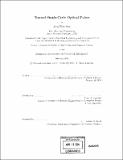Toward single-cycle optical pulses
Author(s)
Kim, Jung-Won, 1976-
DownloadFull printable version (15.06Mb)
Other Contributors
Massachusetts Institute of Technology. Dept. of Electrical Engineering and Computer Science.
Advisor
Franz X. Kaertner.
Terms of use
Metadata
Show full item recordAbstract
Single-cycle optical pulses, the never-before-achieved regime, have a great potential for attosecond science and phase-sensitive nonlinear optics. To achieve single-cycle optical pulses by active synchronization, three major steps are required. Firstly, two very stable and broadband mode-locked lasers with overlapping spectra are necessary. Secondly, a tight timing synchronization with timing jitter under one-tenth of the synthesized pulsewidth has to be implemented. Finally, the carrier-envelope offset frequency lock between two lasers completes the coherent pulse synthesis process. In this thesis, the major ideas, techniques, and experimental results for single-cycle optical pulse synthesis are presented. A broadband Cr:forsterite laser mode-locked by a semiconductor saturable absorber is designed and implemented. The output spectrum spans from 1080 nm to 1500 nm range, and has a 3-dB bandwidth of 90 nm. This is the broadest spectrum from a prismless Cr:forsterite laser to our best knowledge, and corresponds to a sub-20 fs Fourier-transform limited pulsewidth. A new broadband output coupler is designed to optimize the output spectrum of an octavespanning Ti:sapphire laser. The resulting combined spectrum covers 1.5 octave from 600 nm to 1500 nm and has a strong overlap in 1100 to 1200 nm range, which enables a strong beat-note signal between the two lasers. A tight timing synchronization between the two lasers is achieved by balanced cross-correlation. The resulting timing jitter is 300 attoseconds, which is less than one-tenth of the synthesized pulsewidth. (cont.) For a high-quality pulse synthesis, an ultra-broadband 50:50 beam splitter, a bandpass filter beam splitter, and a tapping beam splitter are designed with optical thin-film multilayer structures. A novel scheme for synchronization of an RF-signal to the pulse train of a mode-locked laser is proposed. Currently the isolation of cross-talk between two locking loops for repetition rate and carrier-envelope phase is under investigation, and it is expected to generate true single- cycle optical pulses in the near future. Future work will include full characterization of the synthesized pulses with SPIDER (spectral phase interferometry for direct electric-field reconstruction) and novel phase-sensitive nonlinear optic experiments.
Description
Thesis (S.M.)--Massachusetts Institute of Technology, Dept. of Electrical Engineering and Computer Science, 2004. Includes bibliographical references (p. 143-151).
Date issued
2004Department
Massachusetts Institute of Technology. Department of Electrical Engineering and Computer SciencePublisher
Massachusetts Institute of Technology
Keywords
Electrical Engineering and Computer Science.